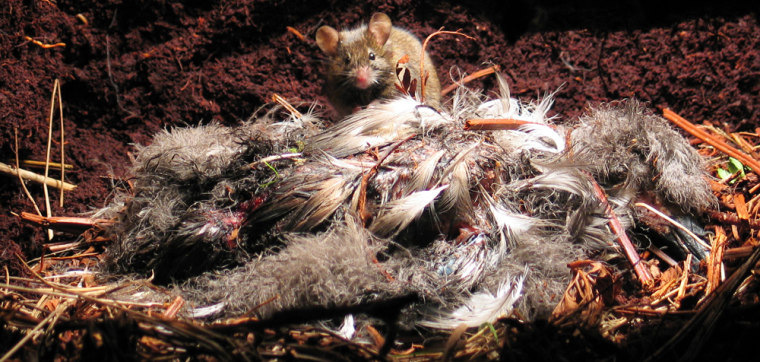“Monster mice” are eating much larger albatross chicks alive, threatening rare bird species on a remote South Atlantic island seen as the world’s most important seabird colony.
Conservationists say the avian massacre is occurring on Gough Island in the South Atlantic, a British territory about 1,000 miles southwest of Cape Town and home to more than 10 million birds.
“Gough Island hosts an astonishing community of seabirds and this catastrophe could make many extinct within decades,” said Geoff Hilton, a senior research biologist with Britain’s Royal Society for the Protection of Birds.
“We think there are about 700,000 mice, which have somehow learned to eat chicks alive,” he said in a statement.
The researchers believe the mice are devouring more than one million petrel, shearwater and albatross chicks on Gough Island every year.
The island is home to 99 percent of the world’s Tristan albatross and Atlantic petrel populations — the birds most often attacked. Just 2,000 Tristan albatross pairs remain.
Like cat attacking a hippo
“The albatross chicks weigh up to 10 kg (22 pounds) and ... the mice weigh just 35 grams; it is like a tabby cat attacking a hippopotamus,” Hilton said.
The house mice — believed to have made their way to Gough decades ago on sealing and whaling ships — have evolved to about three times their normal size.

This is a common phenomenon on island habitats — for reasons much debated among scientists — where small animal species often grow larger while big species such as elephants display “dwarfism” and become smaller.
In the case of the mice of Gough Island, their remarkable growth seems to have been given a boost by a vast reservoir of fresh meat and protein.
The rapacious rodents gnaw into the bodies of the defenseless and flightless chicks, leaving a gaping wound that leads to an agonizing death. Scientists say once one mouse attacks the blood seems to draw others to the feast.
The albatross “are nearly a meter tall and 250 times the weight of the mice but are largely immobile and cannot defend themselves,” RSPB researcher Richard Cuthbert said in the statement. “Without predators this would not be a problem but for a carnivorous mouse population on one of the wettest and windiest places on earth it is an easy meal of almost unimaginable quality. The result is carnage.”
‘Ecologically naive’ birds
While predation by oversized mice is unusual, birds on small islands are especially vulnerable to extinction from human activities such as the introduction of alien species.
This is because many birds that have evolved on isolated islands with no predators have become what biologists term “ecologically naive” — meaning they do not recognize danger from other animals.
Flightless species — or chicks that cannot yet fly — are especially at risk. The predatory nature of the mice was confirmed by researchers from the RSPB and the University of Cape Town.
Scientists suspect the mice are also eating the eggs and chicks of the rare, ground-nesting Gough bunting, a small finch found nowhere else in the world.
Gough Island is the most southerly of the Tristan da Cunha group. There are 22 bird species nesting on the island of which 20 are seabirds.
